Article contents
Diodorus Siculus and Fighting in Relays
Published online by Cambridge University Press: 11 February 2009
Extract
It has been customary to believe that apart from selection and abridgement Diodorus Siculus made little contribution to his  Scholars have admitted the contribution of Diodorus himself when he refers to his native town Agyrium with some pride and to Sicily in general and when he occasionally records details of his own life. Beyond statements of this character, however, the tendency has been to assume that the origin of any particular statement is to be sought in the single source which Diodorus was currently using, or, as others would argue, in the major source supplemented by a subsidiary source, or, as Tarn would postulate for 17, the medley of sources used by the Sicilian historian. An examination of the attribution of one item in 17 may throw some light on Diodorus as an historian.
Scholars have admitted the contribution of Diodorus himself when he refers to his native town Agyrium with some pride and to Sicily in general and when he occasionally records details of his own life. Beyond statements of this character, however, the tendency has been to assume that the origin of any particular statement is to be sought in the single source which Diodorus was currently using, or, as others would argue, in the major source supplemented by a subsidiary source, or, as Tarn would postulate for 17, the medley of sources used by the Sicilian historian. An examination of the attribution of one item in 17 may throw some light on Diodorus as an historian.
- Type
- Research Article
- Information
- Copyright
- Copyright © The Classical Association 1966
References
page 249 note 1 I wish to thank Mr. G. T. Griffith and Dr. E. W. Marsden for valuable criticisms and suggestions.
page 249 note 2 e.g. 4. 24. 1–6, 16. 82. 4–5, 83. 3.
page 249 note 3 e.g. 16. 7. 1.
page 249 note 4 e.g. 1. 4. 1–5, 44. 1, 83. 8–9, 17. 52. 6.
page 249 note 5 Tarn, W. W., Alexander the Great, ii. 63–91.Google Scholar
page 249 note 6 Ibid., p. 72 and n. 2.
page 249 note 7 Of the other sieges recorded by Diodorus, the ![]() launched against the Marmareis (28. 2) might entail the use of relays (though such passages as 11. 76. 1, J 2. 28. 2 and 37. I suggest the phrase should not be pressed), while
launched against the Marmareis (28. 2) might entail the use of relays (though such passages as 11. 76. 1, J 2. 28. 2 and 37. I suggest the phrase should not be pressed), while ![]()
![]() (45. 1) could be a reference to their use at Tyre. The siege of Gaza (48. 7) rates a surprisingly brief mention, while Alexander's assault on the Malli town at least as recorded by Diodorus (98. 1–99. 4) precluded the use of relays.
(45. 1) could be a reference to their use at Tyre. The siege of Gaza (48. 7) rates a surprisingly brief mention, while Alexander's assault on the Malli town at least as recorded by Diodorus (98. 1–99. 4) precluded the use of relays.
page 249 note 8 Miletus: ![]()
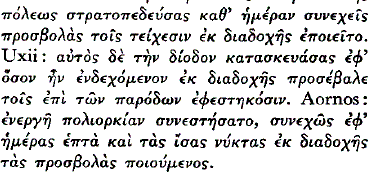
page 249 note 9 ![]()
![]()
page 249 note 10 ![]()

page 250 note 1 17. 12. 2. Cf. also 11. 1 and 12. 1: ![]()
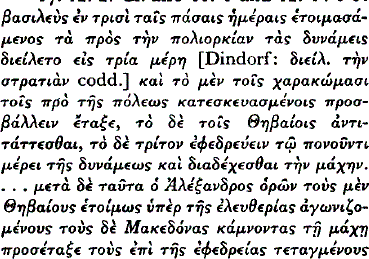
![]() In various respects (especially the circumstances of the commencement of the Macedonian attack) Diodorus* account is probably to be preferred to Arrian's (1. 7. 7–9. 10).
In various respects (especially the circumstances of the commencement of the Macedonian attack) Diodorus* account is probably to be preferred to Arrian's (1. 7. 7–9. 10).
page 250 note 2 Tarn, , op. cit., ii. 72.Google Scholar
page 250 note 3 Plutarch Alexander 25. 1: ![]()
![]()
![]()
![]() See p. 249, n. 7, for Diodorus* account of the siege of Tyre.
See p. 249, n. 7, for Diodorus* account of the siege of Tyre.
page 250 note 4 8. 11. 19.
page 250 note 5 4. 29. 6. Cf. also siege of Rock of Chorienes, where day and night shifts were employed for making ladders (4. 21. 4).
page 250 note 6 C.Q. N.S. xii (1962), 145–6.Google Scholar
page 250 note 7 16. 74* 2, 5: ![]()
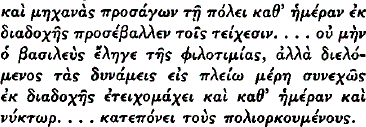
page 250 note 8 Ephorus was probably the source of the Perinthus account; cf. Hammond, N. G. L., C.Q. xxxi (1937), 79–91,Google Scholar and Wüst, F. R., Philipp II von Makedonien und Griechenland, p. 127, n. 3.Google Scholar
page 251 note 1 13. 64. 7. 15. 26. 4, 18. 13- 1. 34. 4. Of interest too is the account of Epaminondas' operations against Sparta in 362: ![]()
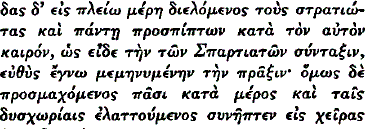 (15. 83. 4.).
(15. 83. 4.).
page 251 note 2 13. 59. 7. 20. 45. 7, 20. 88. 8 and 97. 7.
page 251 note 3 Hell. 1. 2. 18.
page 251 note 4 Ibid. 5. 4. 1–12, Plut. Pel. 7–13, Mor. 594–8, Nepos, Pel. 2–3.
page 251 note 5 Demetr. 8–9 and 21–22.
page 251 note 6 12. 61. 3.
page 251 note 7 11. 7. 2. Cf. 11. 8. 3: ![]()
![]()
page 251 note 8 11. 8. 2.
page 251 note 9 Herodotus 7. 210–12. Cf. especially ![]()

page 252 note 1 4. 11. 3.
page 252 note 2 Herodotus 7. 22: ![]()
page 252 note 3 Thuc. 3. 49. 3: ![]()
![]()
page 252 note 4 Plato, Laws 758 a-d, e.g. ![]()

page 252 note 5 Demosthenes, Phil. 1. 21: ![]()
![]() Cf. Aeschin. 2. 168.
Cf. Aeschin. 2. 168.
page 252 note 6 Thuc. 7. 28. 2: ![]()
![]() Cf. Thuc. 7. 27. 3, Aeneas Tacticus 27. 15, Xen. Cyr. 1.4. 17, and Demosthenes 21. 164.
Cf. Thuc. 7. 27. 3, Aeneas Tacticus 27. 15, Xen. Cyr. 1.4. 17, and Demosthenes 21. 164.
page 252 note 7 Thuc. 2. 75. 3: ![]()
![]()
![]() Cf. p. 250, n. 5.
Cf. p. 250, n. 5.
page 252 note 8 Thuc. 5. 9. 2 and 8; 5. 67.
page 252 note 9 Polybius 18. 32. 2–5, D.H. 9. 57, Onasander 22. 1.
page 252 note 10 Griffith, G. T., The Mercenaries of the Hellenistic World, pp. 30–32.Google Scholar Cf. Thuc. 6. 67, Eur. Phoen. 1095, Xen. Anab. 6. 5. 9.
page 252 note 11 ![]()
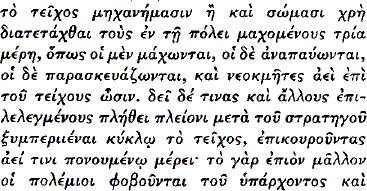
![]() 38. 1–2.
38. 1–2.
page 252 note 12 Cf. Grundy, G. B., Thucydides and the History of his Age, vol. i, pp. 282–91 (esp. p. 285), who stresses Thucydides* interest in siege operations and explains this on the grounds that the Peloponnesian War marked a new phase in the development of siege operations: the novelty lay in the use of active attack. See also Diodorus 12. 28 on the use of siege engines at Samos in 440–439.Google Scholar
page 253 note 1 ![]()
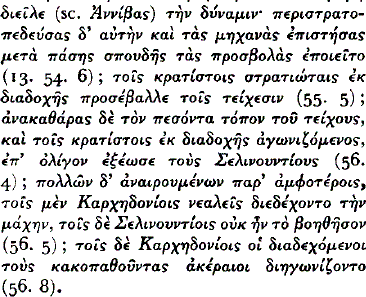
page 253 note 2 The similarity of phraseology to passages already cited might be taken as an indication that in these Sicilian sections Diodorus or his source was ‘reading back’, but the similarity is fully in accord with Palm's conclusions about the homogeneity of Diodorus' style irrespective of source. Cf. Palm, J., Über Sprache und Stil des Diodoros von Sizilien (Lund, 1955).Google Scholar
page 253 note 3 13. 85. 3.
page 253 note 4 13.86. 3.
page 253 note 5 ![]()
![]() (13. 108. 8.)
(13. 108. 8.)
page 253 note 6 11. 20. 1–22. 6.
page 253 note 7 See especially 13. 54.
page 253 note 8 See, for example, 13. 55. 2 (effect on people of Selinus) and 62. 2 (fall of Himera). Cf. 16. 8. 2 (Philip at Amphipolis).
page 253 note 9 Also see Grundy, op. cit., pp. 289–91, on practical and psychological reasons for the infrequent and generally unsuccessful use of storming parties in the Peloponnesian War. Cf. Thuc. 7. 79. 2 for usual fifth-century methods.
page 253 note 10 14. 42. 1. Cf. Schramm, E. on Poliorketik (esp. pp. 216–17) inGoogle ScholarKromayer, and Veith, , Heerwesen und Kriegführung der Griechen und Römer.Google Scholar
page 254 note 1 Alter ms arrival at Liela Uionysius planned a three-pronged infantry attack on the Carthaginian camp, while the cavalry were instructed to join in the fighting if the infantry were successful, but if they were not, ![]() (13. 109. 4–5).
(13. 109. 4–5).
page 254 note 2 At Egesta and Entella, for example, Dionysius launched ![]() (14. 48. 5, and see p. 249, n. 7 above), while at Caulonia (14. 103. 6) andRhegium (14. 108. 3, 6) daily assaults were made. The phrase
(14. 48. 5, and see p. 249, n. 7 above), while at Caulonia (14. 103. 6) andRhegium (14. 108. 3, 6) daily assaults were made. The phrase ![]() is, however, not infrequent in Diodorus—it is used, for instance, of the Gauls at Rome in 387 (14. 115. 6). The account of the siege of Tauro- menium (14. 87. 5–88. 4) contains no im plication of relays, but they may have been impracticable because of the strength of the position and the height of the wall.
is, however, not infrequent in Diodorus—it is used, for instance, of the Gauls at Rome in 387 (14. 115. 6). The account of the siege of Tauro- menium (14. 87. 5–88. 4) contains no im plication of relays, but they may have been impracticable because of the strength of the position and the height of the wall.
page 254 note 3 Philo of Byzantium 98. 45–48—![]()
![]()
![]()
page 254 note 4 See Welles, C. B., Loeb edition of Diodorus, vol. viii, p. 13,Google Scholar on the sources of 17. Justin's omission of relays could not be regarded as refuting the possibility that Diodorus relied on Trogus as a basis for the whole of Greek history, though discrepancies between Justin and Diodorus 16 would alone militate against this view.
page 254 note 5 See p. 255, n. 5.
page 254 note 6 Relays, however, are not implied and at most are not inconsistent with Curtius' de scription: ‘multis ergo uulneribus depulsi, ut quibus non cum hoste solum, sed etiam cum loco dimicandum esset, subibant tamen, quia rex inter primos constiterat, interrogans tot urbium uictores an erubescerent haerere in obsidione castelli exigui et ignobilis, simul admonens Tauronem mox auxilium esse Iaturum.’ (5. 3. 8–9.)
page 255 note 1 See p. 251, n. 6.
page 255 note 2 See p. 251, n. 1 and n. 4.
page 255 note 3 Grote, G., History of Greece, vol. viii, p. 86,Google Scholar n. 3, and von Stern, E., Geschichte der spartanischen und thebanischen Hegemonie, p. 59, n. 1.Google Scholar
page 255 note 4 See, for example, Dinarchus 1. 38–39.
page 255 note 5 Aelian 1 (and Arrian, Tactica, 1). Diodorus' clear interest in sieges and siegeengines (see, for example, 20. 91 or 17. 43–45 with its array of curious weapons) points to an acquaintance with such works, but this is not to say that he worked directly and in detail from a military handbook. It is possible that he did but it would be very difficult to establish.
page 255 note 6 I should like to record my gratitude to the University of Edinburgh and members of its staff for facilities and hospitality during my tenure of a Research Fellowship in 1964.
- 3
- Cited by


